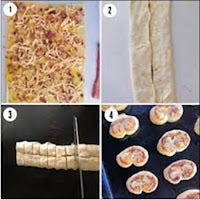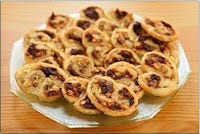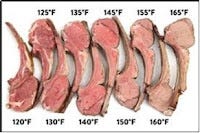Amalie Robert Estate Culinary Inclinations Series Part IV: Rhône Inspires with Black Cod Palmiers and Rack of Spring Lamb
Hello and Welcome,
It’s spring lamb season somewhere. And thanks to the invention of vacuum packaging and cold chain logistics, it can be spring lamb season, right here, right now! This is the fourth segment in our Culinary Inclinations Series: Rhône Inspires with Black Cod Palmiers and Rack of Spring Lamb. A FLOG communication(Farming bLOG) from Dena & Ernie @AmalieRobert Estate. Willamette Valley Oregon Pinot Noir.
Here in the Northern Hemisphere, the lower 48 in particular, we have just had an election. And pretty soon they are going to tell us who won. Not all of the races everywhere of course, but most of them. Enough to get an idea of what the next couple of years might look like. The judiciary is engaged as is “de rigueur” and the electorate is warming up for January 5th. If you live in Georgia, you don’t need us to tell you that the circus has come to town. They are all there, with lawyers in tow.

We are blessed to have the Christmas holiday during the winter solstice. Not so for the folks Down Under. “Chrissy” as it is known, arrives with a sleigh full of gifts in the middle of the summer. It’s shrimps on the barbie and a pint of lager!
To celebrate the holidays, some choose to bring the great outdoors indoors. This often takes the form of a fir, pine or spruce tree. And depending on where said tree is in its lifecycle, it could be a beautifully adorned festive tree with lights and ornaments, or a more practical yuletide log. Either way, it is nice to curl up next to your implementation of the holiday tree with a glass of wine and a nice book or FLOG post as the case may be today.
He who travels fastest, travels alone. And that is how Santa gets everything delivered in one night. Of course, he has several time zones strategically mapped out and works both sides of the equator at the same time. By now, you would have to believe Rudolph has the route down cold. You can even track him on Google while they track you! And check out all of the cool games.
This would seem to be the perfect segue to delve into Viognier. That beautifully textured, heady white wine from the Northern Rhône Valley that Ernie grows right here in block 12, all 297 vines worth. Block 12, as you might imagine is planted east of, and adjacent to, the Syrah block, which is lucky block 13.
All told this is 1,485 vines, about 1.02 acres worth of Northern Rhône inspired viticulture. These vines are surrounded by the most coveted Wadenswil clone Pinot Noir to the north in block 21 and to the east in block 10. Covering the southern flank is Dijon clone 115 and looking to the west, it is Pommard clone that provides cover from the late afternoon sun.

But that was not the original plan. Ernie had those vines penciled in “way the hell and gone” on the other side of the field. Fortunately, and just before it was mostly too late, Dick Erath showed Ernie the error in this thinking.
We didn’t have to dig up that many vines, but that is how you “move” a vineyard block. Once that chore was completed, Ernie promptly invested in a new thinking cap. Dena picked it out. It has a nice pattern but not too flashy. It fits pretty snug and has a side binder to lock it in place. That’s just in case it were to slip off as we approach a critical decision point. Farming thinking caps are different. They just are…

In the winery, we abbreviate Our Muse Viognier as VIOGxx where the xx reflects the vintage. So for the latest release of Viognier we have VIOG19. This is not to be confused with the COVID19 vaccine that just is being released nationwide. However, we do share the same shipping lanes, and they are about to get really busy. So if you are thinking about holiday gift giving, it’s time for you to get busy. Or your gift giving options could be less than optimal.

VIOG19 and smoked black cod palmiers. Our interpretation of this culinary inclination is a savory. We consider a puff pastry to be the perfect delivery vehicle for exquisite smoked black cod and herbed goat cheese.
This is a sheet of thawed puff pastry shmeared with herbed goat cheese and then topped with smoked black cod. Alternatively, you could use lox style smoked salmon on one side. You then roll the opposing sides to the center, much like an ancient scroll. A quick brush of egg wash, slice them about 3/8” of an inch thick, then a run through the oven with a fresh sprig of rosemary at the very end, and out they come just as pretty as you please.

And you can accessorize! A creamy cucumber dill sauce served chilled adds sophistication from the “afternoon high tea” theme. Pesto is a classic accoutrement, however we are not so keen on pine nuts. Our interpretation of this classic substitutes almonds, and we add sun dried tomatoes including a little of the olive oil to the mix. And then there is aioli, lots and lots of ways to go and none of them are wrong. To round out the colors we suggest a roasted red pepper and garlic aioli. Yes, that should do it, very nice indeed!
A note on serving Viognier. We often find Viogner to have a very narrow serving temperature range. Slightly cooler than Pinot Noir, but not so cool as to lose the scintillating aromas that only Viognier can provide. We suggest starting off cool and letting the wine warm in your glass until you achieve maximum olfactory and frontal lobe satisfaction. You will know it when you find it. “Oh, did I say that out loud?” Yeah, that happens…

As your guests are polishing off the palmier plate, quite literally, and have found your last stashed bottle of Our Muse Viognier, it is time to move onto the main course. Lamb rack, or crown roast of lamb for a much more stunning presentation, and Satisfaction Syrah. Often times dressing can be made and cooked separately or in the middle of the roast. We prefer cooking any dressing separately, to ensure the correct temperatures of both dishes are achieved at the proper time. Otherwise, one is left cold, waiting for the other to finish.
One of your first decisions in approaching this culinary inclination is whether to decant the wine, and if so when to do it? Whether you are contemplating our Satisfaction or Top Barrel Syrah, we encourage decanting this wine before serving. And more importantly, here is why.
Wine decanting and whole cluster fermentation. The decision to decant a wine is really all about exposing the wine to air to allow it to evolve into a more enjoyable experience. In most dining situations, air is defined as 78% nitrogen, 21% oxygen and 1% of the stuff that is most likely going to get us all. Let’s concern ourselves with the 21%.

During the winemaking process, we limit the amount of air exposure in our wines. Once fermentation is complete, the wines have a high concentration of carbon dioxide. This is a preservative, and over time this will dissipate. Sulfur dioxide is also a preservative that will dissipate over time and is added to the wine as it matures in barrel. And we do not transfer or rack our wines from barrel to barrel. In the case of our Syrah, once the barrels are filled, that is their home for the next two and half years until we gently transfer the wine to tank and use gravity to bottle – no pumping.
That means your bottle of Amalie Robert Syrah has had very little air exposure. In fact, the only air exposure would have come through that wee little piece of tree bark we use as the cork. And that is by design, we use natural corks precisely because we want that air exchange. While each cork is unique in its air exchange properties, we do know that some oxygen is getting through the cork and interacting with the wine. As air interacts with the wine, its first target is tannin. Oxygen degrades (softens) tannin.
Here is where it gets interesting. Whole cluster fermentations add tannins to the wines from the stems. Stem tannin is different from skin tannin and that’s the only way to get stem tannin - from the stems. And we ferment Syrah with whole clusters. A whole lot of whole clusters, about half the fruit in the fermenter is still attached to the stem. Add about five to seven years in the bottle and that little bit of air that has been slowly softening those stem tannins, has evolved them into spice and texture and length of finish. No other winemaking technique can provide such pleasure, but you have to wait for it to happen in the bottle.
So we say: Hell yes, decant that wine! But do it gently. We recommend sitting the bottle upright for at least 24 hours in a slightly cool area. Pour the wine from the bottle down the side of the decanter trying not to splash the wine. Toward the end of the pour look down through the neck of the bottle for sediment and stop pouring if it becomes excessive. It is harmless, but will make the wine appear cloudy in your glass.

Now you must wait, or plan ahead and decant so the wine is ready when the crown roast and dressing are ready. A good place to start is about an hour before serving time. You can stopper the decanter or use cling wrap to close off the top. There is plenty of air in the decanter to achieve the desired result. They design them that way. Of course, periodic sampling is in order. Be diligent as time permits.

By now your lamb should be making its way to the carving station. If it is an herb encrusted rack of lamb, it should be looking something like this.
Roast winter squash, garlic braised broccolini and sautéed Chanterelle or Morel mushrooms are at the ready. The cheese course should be out of the refrigerator and prepared for service.

Internal temperature is another point of contention among diners. When is it done? How much is too much? What if it is still moving? Here is a handy visual aid to give you a guide to internal temperatures. While this is handy to look at, it is the texture of the meat that is most affected by temperature. That and let the roast set on the carvery for at least 5-10 minutes before carving.
Final Note: We have taken up the practice of washing the dishes and rinsing the stemware the night of, and then washing the stemware the following morning. We find we get more uses from the stemware this way.
Kindest Regards,
Dena & Ernie



